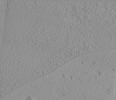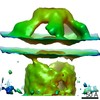[English] 日本語
 Yorodumi
Yorodumi- EMDB-10710: Yeast Tomogram Collected on Lamella Generated by Fully Automated ... -
+ Open data
Open data
- Basic information
Basic information
| Entry | Database: EMDB / ID: EMD-10710 | |||||||||
|---|---|---|---|---|---|---|---|---|---|---|
| Title | Yeast Tomogram Collected on Lamella Generated by Fully Automated FIB Milling | |||||||||
 Map data Map data | Yeast Tomogram Collected on a Lamella Generated by Fully Automated FIB Milling | |||||||||
 Sample Sample |
| |||||||||
| Biological species |  | |||||||||
| Method | electron tomography / cryo EM | |||||||||
 Authors Authors | Zachs T / Pilhofer M | |||||||||
| Funding support |  Switzerland, European Union, 2 items Switzerland, European Union, 2 items
| |||||||||
 Citation Citation |  Journal: Elife / Year: 2020 Journal: Elife / Year: 2020Title: Fully automated, sequential focused ion beam milling for cryo-electron tomography. Authors: Tobias Zachs / Andreas Schertel / João Medeiros / Gregor L Weiss / Jannik Hugener / Joao Matos / Martin Pilhofer /   Abstract: Cryo-electron tomography (cryoET) has become a powerful technique at the interface of structural biology and cell biology, due to its unique ability for imaging cells in their native state and ...Cryo-electron tomography (cryoET) has become a powerful technique at the interface of structural biology and cell biology, due to its unique ability for imaging cells in their native state and determining structures of macromolecular complexes in their cellular context. A limitation of cryoET is its restriction to relatively thin samples. Sample thinning by cryo-focused ion beam (cryoFIB) milling has significantly expanded the range of samples that can be analyzed by cryoET. Unfortunately, cryoFIB milling is low-throughput, time-consuming and manual. Here, we report a method for fully automated sequential cryoFIB preparation of high-quality lamellae, including rough milling and polishing. We reproducibly applied this method to eukaryotic and bacterial model organisms, and show that the resulting lamellae are suitable for cryoET imaging and subtomogram averaging. Since our method reduces the time required for lamella preparation and minimizes the need for user input, we envision the technique will render previously inaccessible projects feasible. | |||||||||
| History |
|
- Structure visualization
Structure visualization
| Movie |
 Movie viewer Movie viewer |
|---|---|
| Supplemental images |
- Downloads & links
Downloads & links
-EMDB archive
| Map data |  emd_10710.map.gz emd_10710.map.gz | 263.8 MB |  EMDB map data format EMDB map data format | |
|---|---|---|---|---|
| Header (meta data) |  emd-10710-v30.xml emd-10710-v30.xml emd-10710.xml emd-10710.xml | 8.3 KB 8.3 KB | Display Display |  EMDB header EMDB header |
| Images |  emd_10710.png emd_10710.png | 147.1 KB | ||
| Archive directory |  http://ftp.pdbj.org/pub/emdb/structures/EMD-10710 http://ftp.pdbj.org/pub/emdb/structures/EMD-10710 ftp://ftp.pdbj.org/pub/emdb/structures/EMD-10710 ftp://ftp.pdbj.org/pub/emdb/structures/EMD-10710 | HTTPS FTP |
-Validation report
| Summary document |  emd_10710_validation.pdf.gz emd_10710_validation.pdf.gz | 145.9 KB | Display |  EMDB validaton report EMDB validaton report |
|---|---|---|---|---|
| Full document |  emd_10710_full_validation.pdf.gz emd_10710_full_validation.pdf.gz | 145 KB | Display | |
| Data in XML |  emd_10710_validation.xml.gz emd_10710_validation.xml.gz | 8 KB | Display | |
| Arichive directory |  https://ftp.pdbj.org/pub/emdb/validation_reports/EMD-10710 https://ftp.pdbj.org/pub/emdb/validation_reports/EMD-10710 ftp://ftp.pdbj.org/pub/emdb/validation_reports/EMD-10710 ftp://ftp.pdbj.org/pub/emdb/validation_reports/EMD-10710 | HTTPS FTP |
-Related structure data
| Related structure data | C: citing same article ( |
|---|---|
| EM raw data |  EMPIAR-10376 (Title: Yeast Tilt Series Collected on Lamella Generated by Fully Automated FIB Milling EMPIAR-10376 (Title: Yeast Tilt Series Collected on Lamella Generated by Fully Automated FIB MillingData size: 2.6 Data #1: Yeast Tilt Series Collected on Lamella Generated by Fully Automated FIB Milling [tilt series]) |
- Links
Links
| EMDB pages |  EMDB (EBI/PDBe) / EMDB (EBI/PDBe) /  EMDataResource EMDataResource |
|---|
- Map
Map
| File |  Download / File: emd_10710.map.gz / Format: CCP4 / Size: 571.2 MB / Type: IMAGE STORED AS SIGNED INTEGER (2 BYTES) Download / File: emd_10710.map.gz / Format: CCP4 / Size: 571.2 MB / Type: IMAGE STORED AS SIGNED INTEGER (2 BYTES) | ||||||||||||||||||||||||||||||||||||||||||||||||||||||||||||
|---|---|---|---|---|---|---|---|---|---|---|---|---|---|---|---|---|---|---|---|---|---|---|---|---|---|---|---|---|---|---|---|---|---|---|---|---|---|---|---|---|---|---|---|---|---|---|---|---|---|---|---|---|---|---|---|---|---|---|---|---|---|
| Annotation | Yeast Tomogram Collected on a Lamella Generated by Fully Automated FIB Milling | ||||||||||||||||||||||||||||||||||||||||||||||||||||||||||||
| Projections & slices | Image control
Images are generated by Spider. generated in cubic-lattice coordinate | ||||||||||||||||||||||||||||||||||||||||||||||||||||||||||||
| Voxel size | X=Y=Z: 18.28 Å | ||||||||||||||||||||||||||||||||||||||||||||||||||||||||||||
| Density |
| ||||||||||||||||||||||||||||||||||||||||||||||||||||||||||||
| Symmetry | Space group: 1 | ||||||||||||||||||||||||||||||||||||||||||||||||||||||||||||
| Details | EMDB XML:
CCP4 map header:
| ||||||||||||||||||||||||||||||||||||||||||||||||||||||||||||
-Supplemental data
- Sample components
Sample components
-Entire : Yeast strain SK1
| Entire | Name: Yeast strain SK1 |
|---|---|
| Components |
|
-Supramolecule #1: Yeast strain SK1
| Supramolecule | Name: Yeast strain SK1 / type: cell / ID: 1 / Parent: 0 |
|---|---|
| Source (natural) | Organism:  |
-Experimental details
-Structure determination
| Method | cryo EM |
|---|---|
 Processing Processing | electron tomography |
| Aggregation state | cell |
- Sample preparation
Sample preparation
| Buffer | pH: 7 |
|---|---|
| Vitrification | Cryogen name: ETHANE-PROPANE |
| Sectioning | Focused ion beam - Instrument: OTHER / Focused ion beam - Ion: OTHER / Focused ion beam - Voltage: 30 kV / Focused ion beam - Current: 0.005 nA / Focused ion beam - Duration: 1545 sec. / Focused ion beam - Temperature: 121 K / Focused ion beam - Initial thickness: 2000 nm / Focused ion beam - Final thickness: 243 nm Focused ion beam - Details: The value given for _emd_sectioning_focused_ion_beam.instrument is Zeiss CrossBeam 550. This is not in a list of allowed values set(['DB235', 'OTHER']) so OTHER is written into the XML file. |
- Electron microscopy
Electron microscopy
| Microscope | FEI TITAN KRIOS |
|---|---|
| Image recording | Film or detector model: GATAN K3 BIOQUANTUM (6k x 4k) / Average electron dose: 1.96 e/Å2 |
| Electron beam | Acceleration voltage: 300 kV / Electron source:  FIELD EMISSION GUN FIELD EMISSION GUN |
| Electron optics | Illumination mode: FLOOD BEAM / Imaging mode: BRIGHT FIELD |
| Experimental equipment |  Model: Titan Krios / Image courtesy: FEI Company |
- Image processing
Image processing
| Final reconstruction | Number images used: 61 |
|---|
 Movie
Movie Controller
Controller





 Z (Sec.)
Z (Sec.) Y (Row.)
Y (Row.) X (Col.)
X (Col.)

















